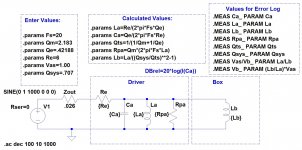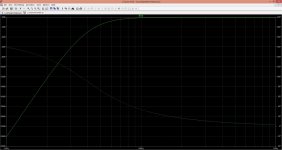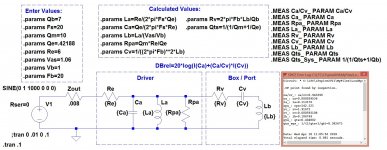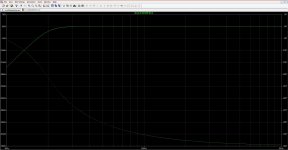Did you know that you can model electro-acoustic properties of loudspeakers? I use LTSpice for my simulations. I create a circuit based on the electro-mechanical properties of a woofer, and an enclosure. It takes the form of a high pass filter of sorts. Using Thiele-Small parameters, you can convert them into a circuit. I am attaching a screenshot example acoustic suspension speaker system with a system Q of .707. You can plot frequency response, impedance, phase or anything you wish. This model has an amplifier with a damping factor of about 300. I also model ported systems. I can show an example of that if there is any interest.
Jim
Jim
Attachments
I've never tried to include the enclosure in the model, but I did mess about with this in AIMSpice many years ago. Without using the T/S parameters, I just adjusted the various RCL values until the impedance plot matched a driver I had (Pionneer A11 IIRC) and played around with adding crossovers, zobels and Z-peak correction circuits. It was quite educative.
The model can be made as complex as you want, but it will have little effect on the box volume and/or tuning condition IMHO. Thiele showed more complex models in 1971 but opted for the simpler model for design.
The ported model is similar to the one shown but contains 2 more elements that are of consequence. Since there is a vent capacitance, there is also a resistance associated with it. This is used to calculate the box leakage Q.
Tuning conditions for ported designs are selected based on Butterworth, Chebyshev, or whatever filter you prefer. Again, the simple model is best for these calculations. The other elements will have little effect on box and tuning conditions.
More complex models can be created based on actual measurement of specific drivers. From this you could get more accurate impedance/phase plots.
Jim
The ported model is similar to the one shown but contains 2 more elements that are of consequence. Since there is a vent capacitance, there is also a resistance associated with it. This is used to calculate the box leakage Q.
Tuning conditions for ported designs are selected based on Butterworth, Chebyshev, or whatever filter you prefer. Again, the simple model is best for these calculations. The other elements will have little effect on box and tuning conditions.
More complex models can be created based on actual measurement of specific drivers. From this you could get more accurate impedance/phase plots.
Jim
It’s good to do this to show that all this theory comes down to networks of RLC lumped elements. It works of course, but Spice really is best left for the design of the electronics and amps.
Akabak is a scripting language for modeling acoustic systems using lumped element and is basically doing the same thing but has all the functionality of modeling speakers built in. It also handles the diffraction, wave propagation in horns waveguides, velocity, etc. In the end, T/S parameters are just RLC equivalents of a driver. Sure we can do it in a Spice, but let’s use the optimal tool for the job.
One can use a pipe wrench as a hammer, but we have hammers for the job.
Akabak also has electrical elements like RLC, and opamps, etc and ok to use for occasional BSC or XO. But a power amp should be modeled on LTspice. Same thing.
Akabak
Akabak is a scripting language for modeling acoustic systems using lumped element and is basically doing the same thing but has all the functionality of modeling speakers built in. It also handles the diffraction, wave propagation in horns waveguides, velocity, etc. In the end, T/S parameters are just RLC equivalents of a driver. Sure we can do it in a Spice, but let’s use the optimal tool for the job.
One can use a pipe wrench as a hammer, but we have hammers for the job.
Akabak also has electrical elements like RLC, and opamps, etc and ok to use for occasional BSC or XO. But a power amp should be modeled on LTspice. Same thing.
Akabak
Last edited:
I think you missed the point of this. A.N. Thiele solved the mystery of ported loudspeaker design by converting the electro-mechanical properties of a speaker system into a circuit. The idea being that once these parameters are known, the values can be calculated for known filter types. As an example, a ported system can be designed as a Butterworth filter as quasi third order (QTS less than .383) or a forth order if Qts is .383. The poles are zero for orders 1 and 2 in first case and zero for 1,2 and 3 in second case. SPICE is great for modeling filters.
If Thiele solved the mystery of ported loudspeaker design, why are there still so many horrid sounding examples inhabiting modern showrooms?
Perhaps there’s an element of art to balancing the numerous comprises involved in creation of a musically pleasing sounding system than just crunching numbers?
Perhaps there’s an element of art to balancing the numerous comprises involved in creation of a musically pleasing sounding system than just crunching numbers?
This is very interesting!
Hi, I am new to the forum. someone redirected me to this thread because I want to know how to model some of my loudspeakers. But if I understand correctly this goes one beyond and models the acoustic properties as filters as well?
How do you make these measurements and where do you get the values for Qb, Fs etc.
Thanks, Rei.
Hi, I am new to the forum. someone redirected me to this thread because I want to know how to model some of my loudspeakers. But if I understand correctly this goes one beyond and models the acoustic properties as filters as well?
How do you make these measurements and where do you get the values for Qb, Fs etc.
Thanks, Rei.
Here is a link to Thiele’s paper part 2 which has example calculations and a way to measure Qb. I wrote software that resolves alignments for 3 filter types based on TS parameters. I will make it available for download soon.
https://www.element14.com/community/docs/DOC-22322/l/thiele-loudspeakers-in-vented-boxes-part-iipdf
https://www.element14.com/community/docs/DOC-22322/l/thiele-loudspeakers-in-vented-boxes-part-iipdf
- Status
- This old topic is closed. If you want to reopen this topic, contact a moderator using the "Report Post" button.
- Home
- Loudspeakers
- Full Range
- Spice Modeling Acoustic Properties of Speakers



